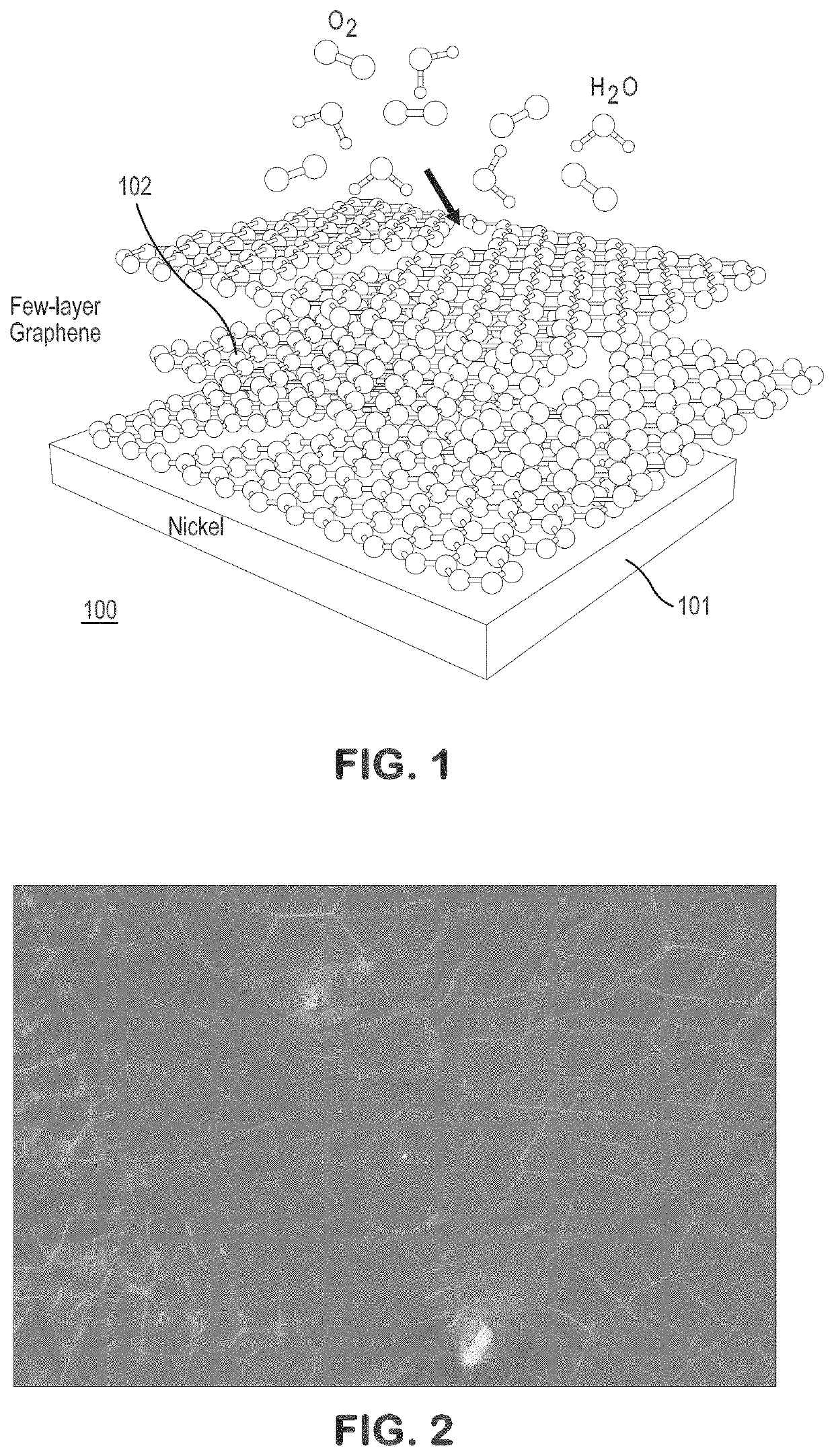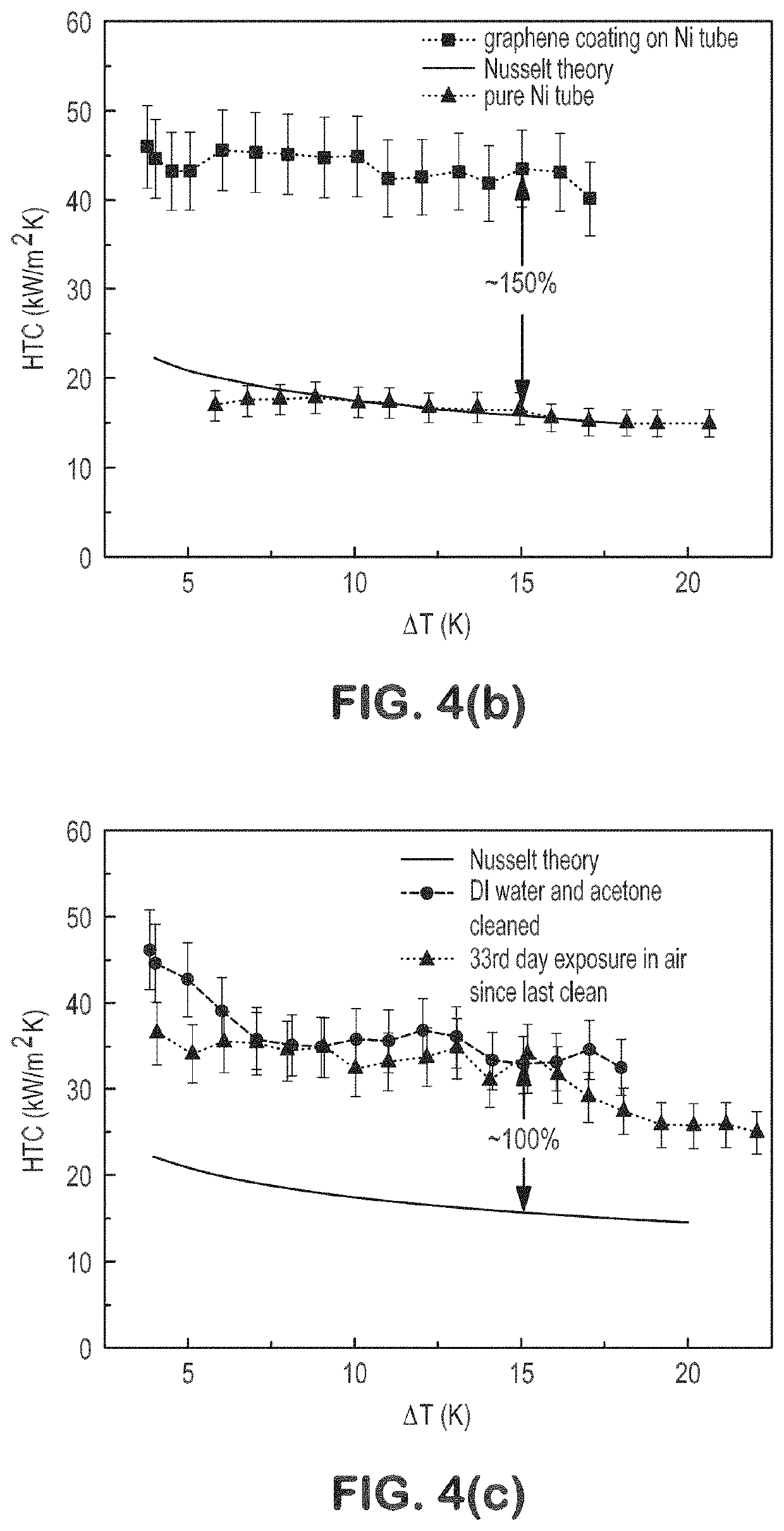Manufacturable metal-graphene interface for highly efficient and durable heat exchanger components
a technology of heat exchanger components and metal graphene, which is applied in the direction of indirect heat exchangers, refrigeration components, light and heating apparatus, etc., can solve the problems of poor heat conductivity of hydrophobic materials, waste of 50% or more energy, and inefficient heat transfer across condensing elements, so as to improve condensation efficiency and durability, and reduce maintenance costs. , the effect of improving energy efficiency
- Summary
- Abstract
- Description
- Claims
- Application Information
AI Technical Summary
Benefits of technology
Problems solved by technology
Method used
Image
Examples
example 1
[0046]Nickel-graphene composite surfaces were produced. FIG. 4(a) shows a Raman spectroscopy graph for one, two, and three layers of graphene on a nickel substrate. FIG. 4(b) shows heat transfer coefficients (HTCs) of a pure nickel tube and a nickel tube having graphene layers. It can be seen that the nickel-graphene surface is able to produce approximately 150% greater heat transfer than the nickel tube without graphene. FIG. 4(c) shows HTCs after a period of 33 days. It shows that the nickel-graphene composite surface maintained superior heat transfer over the nickel only surface.
example 2
[0047]Both copper-graphene-monolayer and nickel-graphene-multilayer interfaces were prepared for steam condensation testing. Both surfaces were examined by X-ray photoelectron spectroscopy (XPS) before and after condensation experiments. As illustrated by FIG. 5(a), copper-graphene was oxidized after one two-hour test and quickly lost its graphene enhancement. In contrast, after a month-long test in air, the nickel-graphene composite did not show much oxidation, as seen in FIGS. 5(b), 5(c), and 5(d). The slight degradation in HTCs is likely due to the accumulation of hydroxyl groups (FIG. 5(b)), which increased with test time (FIG. 5(c)). This study shows that nickel-graphene interfaces exhibit superior anticorrosion properties in harsh steam environments. The superior durability of the nickel-graphene interface could be due to the similarities in thermal expansion between nickel and graphene. The thermal expansion mismatch between the graphene monolayer and the copper substrate is ...
example 3
[0049]Corrosion studies were performed using Tafel analysis. FIG. 7(a) shows the corrosion rates of copper-graphene interfaces and FIG. 7(b) shows the corrosion rates of nickel-graphene interfaces. As illustrated in FIG. 7(a), copper-graphene initially shows a low corrosion rate. However, once corrosion starts to occur locally, the corrosion rate begins to accelerate rapidly and globally. In contrast, and as illustrated in FIG. 7(b), the nickel-graphene interface is extremely stable and showed an approximately 450× lower corrosion rate even after a fourth test.
[0050]These and other modifications and variations to the present invention may be practiced by those of ordinary skill in the art, without departing from the spirit and scope of the present invention, which is more particularly set forth in the appended claims. In addition, it should be understood the aspects of the various embodiments may be interchanged both in whole or in part. Furthermore, those of ordinary skill in the a...
PUM
| Property | Measurement | Unit |
|---|---|---|
| thickness | aaaaa | aaaaa |
| thickness | aaaaa | aaaaa |
| thickness | aaaaa | aaaaa |
Abstract
Description
Claims
Application Information
 Login to View More
Login to View More - R&D
- Intellectual Property
- Life Sciences
- Materials
- Tech Scout
- Unparalleled Data Quality
- Higher Quality Content
- 60% Fewer Hallucinations
Browse by: Latest US Patents, China's latest patents, Technical Efficacy Thesaurus, Application Domain, Technology Topic, Popular Technical Reports.
© 2025 PatSnap. All rights reserved.Legal|Privacy policy|Modern Slavery Act Transparency Statement|Sitemap|About US| Contact US: help@patsnap.com



